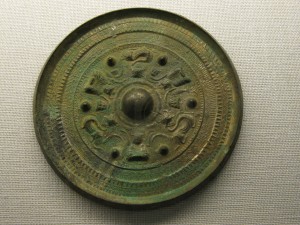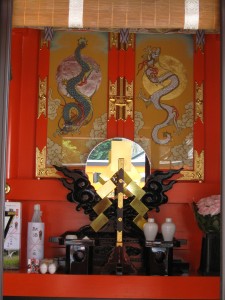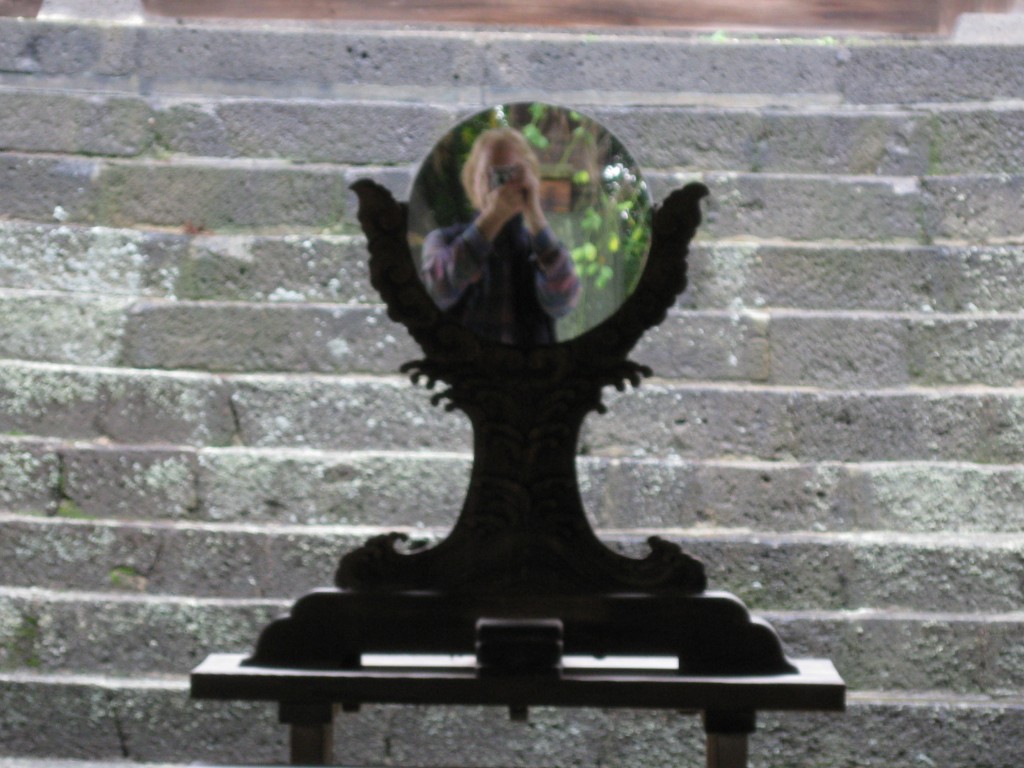
Back of an ancient bronze mirror, in the past a precious item and symbol of authority
The circular mirror of Shinto is a potent symbol. One often sees it when visiting shrines, where it stands on the altar as representative of the kami. It can play a more vital role too, for it sometimes functions as the ‘spirit-body’ (goshintai) of the kami. The idea is that the spirit enters into the object to take physical form. The mirror thus acts as an interface between the physical and spiritual realms of existence. What could be more appropriate for the meeting between them than the illusionary nature of a reflecting mirror?
Japanese mythology claims that the original ‘spirit-body’ was that of Amaterasu, the Sun Goddess, who gave a circular mirror to her grandson, Ninigi, when he descended to earth. It had been used previously in an elaborate ruse to lure her out of a cave in which she was hiding. Her absence had plunged the world into darkness, and to tempt her out she was told that there was another goddess as beautiful as herself. The mirror was held up so that when she peeked out she was greeted by her own radiance, and the momentary hesitation allowed a rope to be tied across the cave entrance so as to prevent her from re-entering. Sunlight was restored to the world.
Later when Amaterasu decreed that a mission be sent down to earth from the High Plains of Heaven, her grandson Ninigi-no-mikoto was chosen to lead it. Before he departed, she presented him with the very same mirror which had played such an important part in the rock-cave incident. ‘Take this and revere it as if it were myself,’ she told him. Within the reflecting surface something of her essence had become ingrained.

Mirror at Kuzuryu Shingu, near Hakone
According to the mythology, Ninigi passed the mirror down to his heirs, who formed the imperial line which continues to this day (the present emperor is the 125th). For a long time the mirror was kept in the palace of the king of Yamato, the dominant state in ancient Japan, but in the early centuries of the Common Era it was deposited at Ise Jingu. Since that time it has been kept secluded from human eye, acting as the unseen focus of worship for the millions of pilgrims and worshippers who file before it each year. As the ancestral shrine of the imperial family, Ise is considered Japan’s premier shrine, housing the country’s holiest of holies.
The idea of a circular mirror serving as spirit of a sun goddess might well strike some as odd. But it’s worth noting that the ancient Chinese believed the human soul to be a shining disc, a connotation that carried over to the circular mirror. For ancient humans it was seen as a means of spirit possession, just as some tribes in modern times were afraid of being photographed lest the camera steal their soul. Reflection and reality were colluded, as indeed they tend to be in the mind of the observer even now.
In modern shrines the mirror that sits on the altar represents the spirit of the enshrined kami. Purity, gratitude, awe are the feelings that it is intended to invoke. Yet in some shrines the mirror is fixed at such an angle that when worshippers pray, they find they are looking at their own reflection. How suggestive! People are praying to themselves! But it’s not a case of worshipping your own ego so much as worshipping the divine within yourself. As the children of the kami, humans too are part of the divine order and live in a sacred world. It’s this life-affirming assertion which is part of the appeal of Shinto.

The altar mirror reflects another world

Leave a Reply